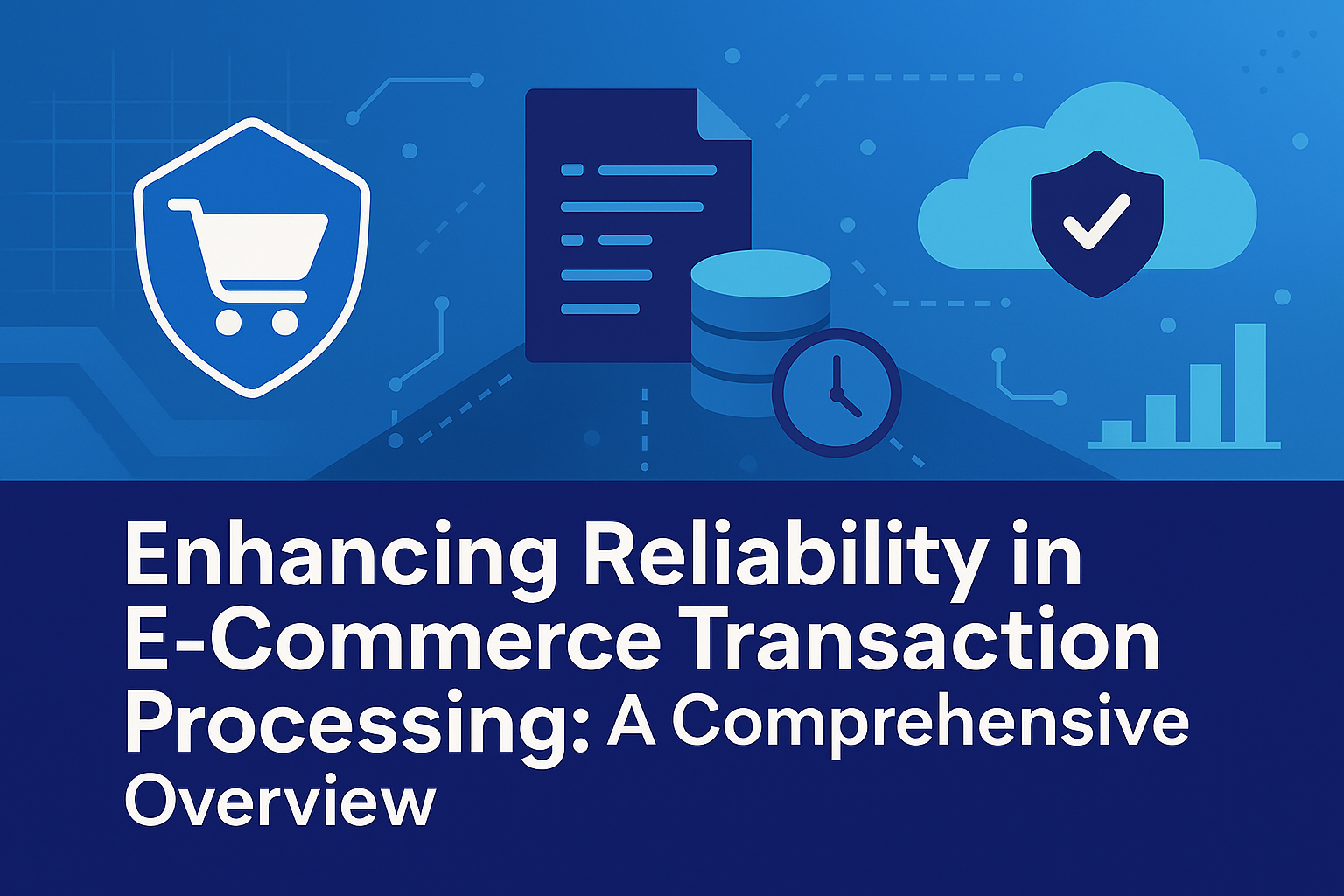In the domain of e-commerce transaction processing, a reliable workload is characterized by its ability to consistently fulfill predefined reliability objectives, such as ensuring seamless order placement, payment authorization, and inventory updates without interruption. This reliability is achieved through proactive measures to avoid potential disruptions, including hardware failures, network issues, or software bugs, while also incorporating mechanisms to tolerate and mitigate the effects of unavoidable events. During such incidents, the system must sustain operational functionality at a predetermined performance level, as mutually agreed upon by stakeholders such as business owners, developers, and end-users. In scenarios involving catastrophic failures—such as a widespread data center outage—the workload should facilitate recovery to a fully operational state within a specified timeframe, often measured in terms of Recovery Time Objective (RTO) and Recovery Point Objective (RPO). A well-structured incident response plan, encompassing detection protocols, escalation procedures, and recovery strategies, is indispensable for minimizing downtime and restoring normalcy efficiently.
When architecting e-commerce systems focused on transaction processing, it is imperative to assess how decisions aligned with reliability design principles—drawn from established frameworks and design review checklists—affect other foundational architectural pillars, including security, cost optimization, operational excellence, and performance efficiency. While these decisions may bolster reliability by introducing redundancy and fault-tolerant mechanisms, they frequently entail tradeoffs that could compromise objectives in adjacent pillars. This expanded discussion delves deeper into these tradeoffs, providing detailed explanations of underlying concepts, potential implications, and real-world e-commerce examples to illustrate their practical manifestations.
Balancing Reliability and Security in E-Commerce Transactions
Security in e-commerce transaction processing prioritizes the protection of sensitive data, such as customer payment details and personal information, through principles like least privilege and zero-trust architecture. However, enhancing reliability often conflicts with these goals by expanding system complexity and exposure.
Expanded Exposure to Potential Threats
A core security tenet is to minimize the attack surface—the sum of all possible entry points for unauthorized access—to reduce vulnerabilities and streamline the application of controls like encryption, access policies, and intrusion detection systems. Reliability strategies, conversely, frequently rely on replication to ensure continuity.
In transaction processing, data replication involves duplicating critical elements, such as databases or services, at various levels: component-level (e.g., multiple instances of a payment processor), data-level (e.g., mirroring transaction logs), or geographic-level (e.g., across multiple cloud regions). For example, Amazon’s e-commerce platform employs Amazon RDS with multi-AZ replication for its order databases, which safeguards against zonal failures but inherently enlarges the attack surface. Each replica requires independent security configurations, potentially introducing inconsistencies or overlooked patches that adversaries could exploit via distributed denial-of-service (DDoS) attacks or lateral movement within the network.
Disaster recovery solutions, including automated backups and failover sites, further contribute to this expansion. These elements are often segregated from production environments to limit risk, yet they necessitate bespoke security measures, such as encrypted storage and role-based access controls specific to recovery operations. In a practical context, Shopify’s backup systems for merchant transaction data are isolated but still demand vigilant monitoring to prevent breaches, as seen in historical incidents where backup repositories became targets for ransomware.
Moreover, incorporating auxiliary components for resilience—such as a message bus like RabbitMQ for decoupling order fulfillment from payment processing—enhances fault tolerance by allowing asynchronous operations. However, this introduces new codebases, dependencies, and interfaces that must be secured. In an e-commerce setup akin to Walmart’s, adding such a bus during high-traffic events like Cyber Monday increases the overall surface area, requiring additional vulnerability scans and potentially novel authentication methods not previously implemented, thereby elevating the risk of configuration errors.
Circumvention of Security Measures During Incidents
Security frameworks advocate for unwavering enforcement of controls, regardless of system state, to maintain integrity. Reliability events, however, can induce pressures that lead to temporary relaxations.
Under active incident response, such as addressing a transaction queue backlog during a flash sale, teams may feel compelled to bypass controls like multi-factor authentication (MFA) or audit logging to expedite resolution. This urgency stems from the need to restore service quickly, but it heightens exposure in an already compromised system. A notable example occurred during a 2023 outage at a major retailer, where diagnostic access bypassed standard protocols, inadvertently allowing potential data exfiltration if malicious actors were present.
Troubleshooting often involves disabling protocols temporarily, with the risk that reinstatements are delayed due to oversight or ongoing chaos. Granular controls, such as custom firewall rules for API endpoints in payment gateways, add layers of complexity that increase misconfiguration likelihood. To mitigate reliability impacts from these configurations—e.g., rules blocking legitimate failover traffic—teams might opt for broader permissions, which erode zero-trust pillars of explicit verification, least privilege, and assumed breach. PayPal’s transaction systems, which rely on precise role-based access, exemplify this tension: broadening rules for smoother operations could facilitate unauthorized access, as evidenced in industry reports on similar compromises.
Retention of Outdated Software Components
Security best practices endorse a “get current, stay current” strategy, involving regular patching to counter emerging threats like zero-day vulnerabilities.
Updates to transaction processing software, however, can induce downtime or instability, prompting delays that preserve short-term reliability at the expense of long-term security. For instance, patching a vulnerability in an Apache server handling e-commerce APIs might require a restart, disrupting live transactions. In cases like Stripe’s payment infrastructure, deferring such updates avoids immediate outages but exposes systems to exploits, as seen in past breaches involving unpatched libraries.
This dilemma extends to application code, including outdated dependencies in custom e-commerce apps. An online marketplace using legacy JavaScript frameworks for cart management might view updates as reliability risks due to potential compatibility issues, yet this perpetuates exposure to known vulnerabilities, such as those cataloged in the OWASP Top Ten.
Navigating Reliability and Cost Optimization in E-Commerce
Cost optimization seeks to align expenditures with value, minimizing idle resources and over-provisioning. Reliability enhancements, however, often demand investments that appear inefficient.
Heightened Redundancy Leading to Resource Inefficiency
Replication for fault tolerance requires maintaining surplus capacity, calibrated to withstand a defined number of failures. Higher tolerance thresholds necessitate more replicas, inflating costs. eBay’s auction platform, for instance, scales replicas based on failure models, but excessive redundancy during low-traffic periods results in underutilized compute resources.
Over-provisioning mitigates sudden loads, such as during failovers, but unused capacity constitutes waste. Target’s e-commerce system provisions extra servers for holiday peaks, ensuring transaction reliability yet incurring costs for idle infrastructure.
Disaster recovery setups exceeding RTO/RPO needs amplify expenses through unnecessary replication or storage. Smaller retailers might over-invest in real-time geo-redundant backups when periodic snapshots suffice, leading to avoidable cloud storage fees.
Deployment strategies like blue/green, which duplicate environments for zero-downtime updates, transiently double costs. In agile environments like Zappos, frequent deployments exacerbate this, as each cycle incurs overlapping resource usage.
Elevated Operational Investments Beyond Core Needs
Reliability mandates observability, testing, and support structures that may not directly correlate with functional outputs.
Monitoring transaction health generates voluminous data, with advanced tools like Datadog increasing transfer and analysis costs as granularity rises. Etsy’s platform, for example, monitors payment latencies in detail, but this escalates expenses without proportional revenue gains.
Testing regimes, including load simulations and chaos experiments, require dedicated environments and expertise. Alibaba’s drills for transaction resilience involve custom tooling, representing significant time and financial outlays.
High-reliability operations often include on-call rotations, entailing personnel salaries, training, and paging systems. This diverts resources from innovation, as in Alibaba’s 24/7 teams focused on incident response.
Over-provisioned support contracts with vendors, such as premium tiers from AWS unused in stable periods, embody pure waste in cost-optimized frameworks.
Addressing Reliability and Operational Excellence in E-Commerce
Operational excellence emphasizes streamlined processes and knowledge management, but reliability introduces multifaceted complexities.
Amplified Complexity in System Management
Reliability patterns add components, expanding deployment orchestration and configuration scopes. Netflix-inspired microservices in transaction systems complicate versioning and rollouts.
Observability for distributed tracing grows intricate with added sources. Uber Eats’ transaction monitoring integrates multiple logs, demanding sophisticated aggregation tools.
Multi-region architectures for capacity and failover necessitate cross-region synchronization. Walmart’s global setup requires managing data consistency across latencies, heightening operational overhead.
Greater Demands on Knowledge Maintenance
Documentation for resilient architectures expands with each addition. BigCommerce’s failover procedures require ongoing updates to reflect evolving components.
Training and onboarding extend as system breadth increases, necessitating familiarity with roadmaps and guidelines for services like payment APIs in Shein’s dynamic environment.
Optimizing Reliability Alongside Performance Efficiency in E-Commerce
Performance efficiency targets optimal response times and resource utilization, but reliability tactics can introduce overheads.
Potential Increases in Response Times
Replication for data durability adds synchronization delays. MongoDB’s synchronous writes in retail transaction logs, as in some implementations, consume latency budgets for user-facing operations like checkout.
Load balancers for traffic distribution insert processing hops. Flipkart’s balancers during sales events marginally slow requests while ensuring even distribution.
Geographic spreads for zonal resilience incur network traversal costs. AWS cross-AZ communications in e-commerce APIs delay inter-service calls, impacting end-to-end performance.
Intensive monitoring instrumentation can degrade throughput. Over-instrumented Magento setups for health checks introduce CPU overhead, reducing transaction per second rates.
Excessive Resource Allocation for Peak Demands
Scaling lags necessitate over-provisioning for bursts. Best Buy’s platforms use oversized clusters for sales, preserving reliability but violating just-in-time efficiency.
For unpredictable components, worst-case sizing leads to chronic underutilization. Square’s payment systems, provisioned for peak fraud detection loads, waste resources in nominal scenarios.




